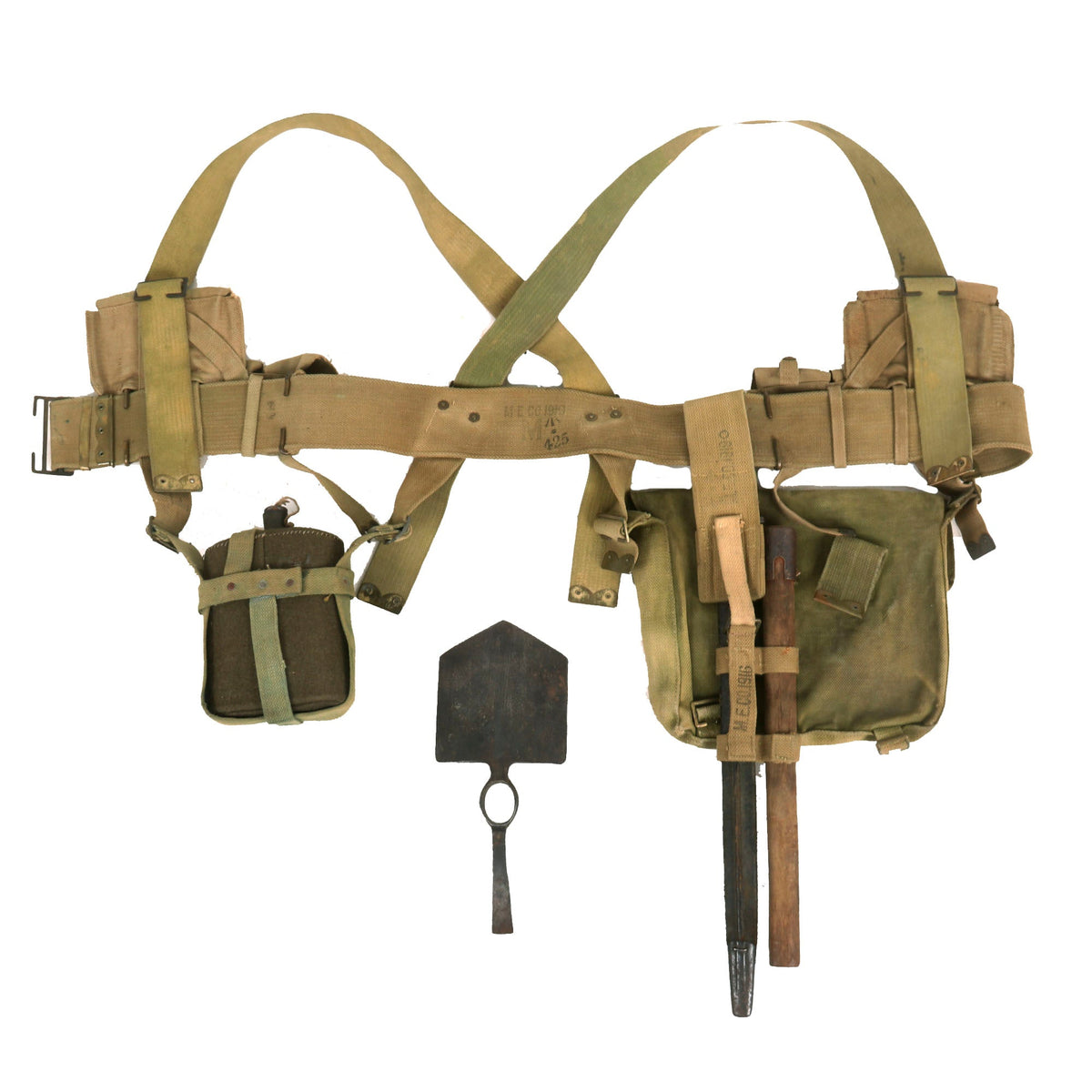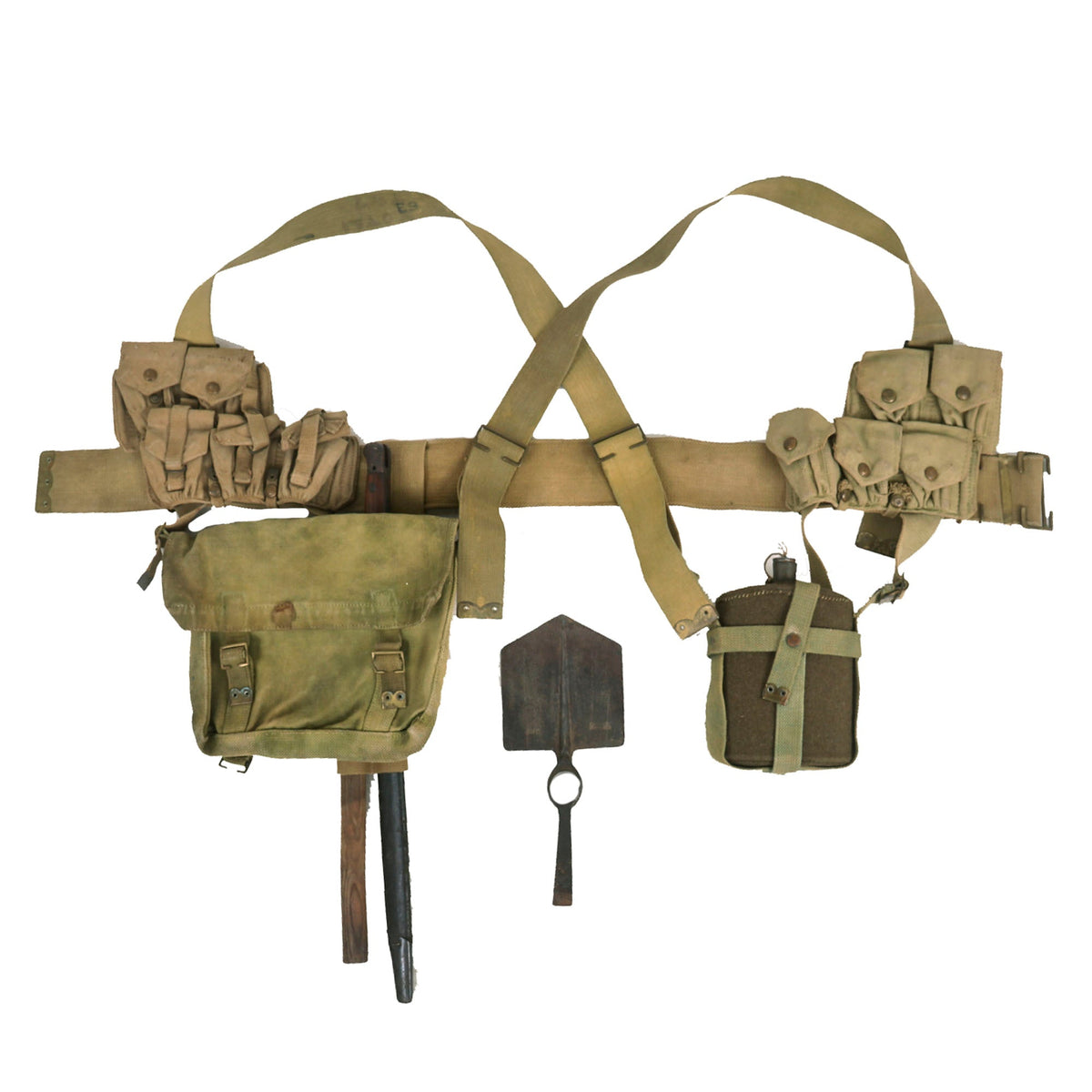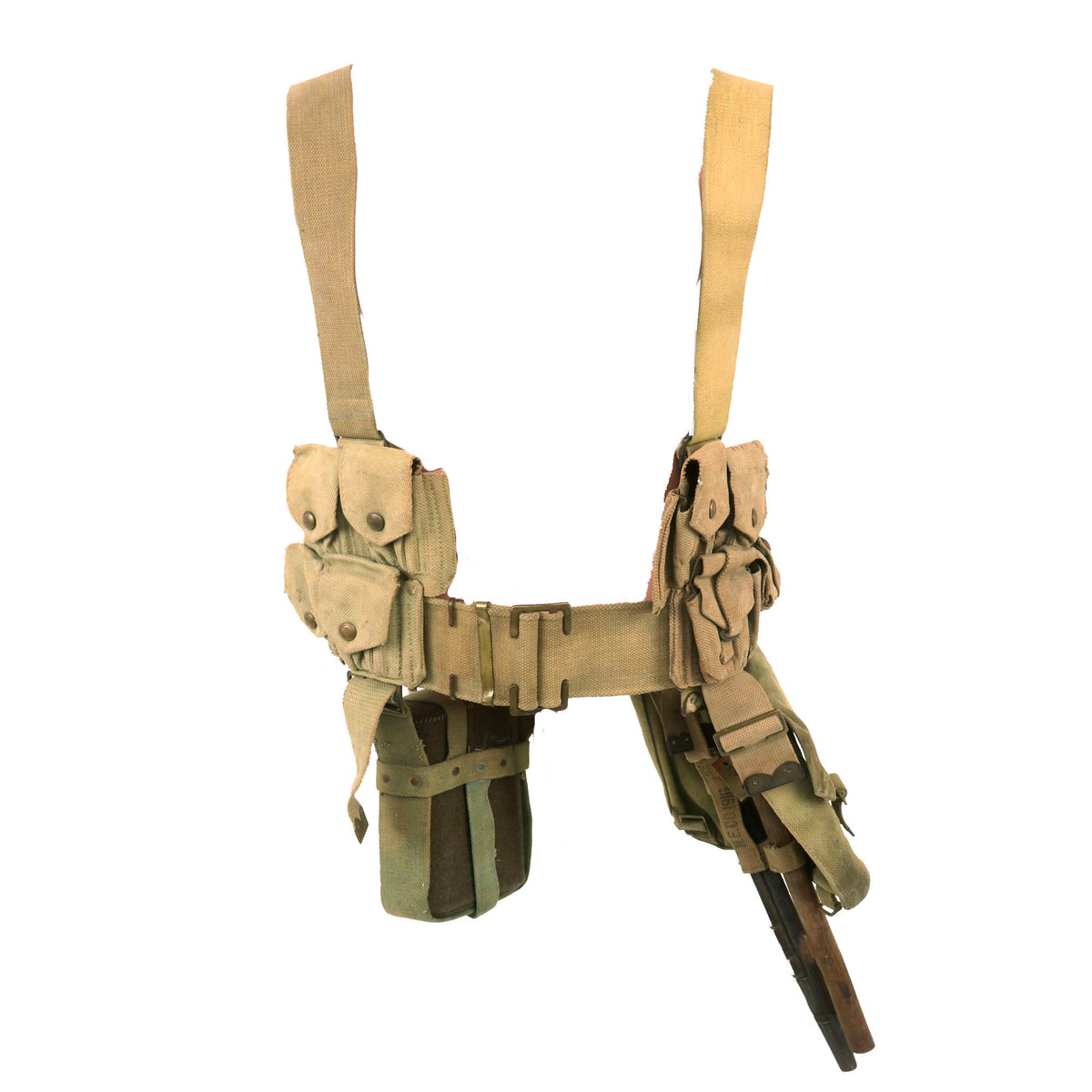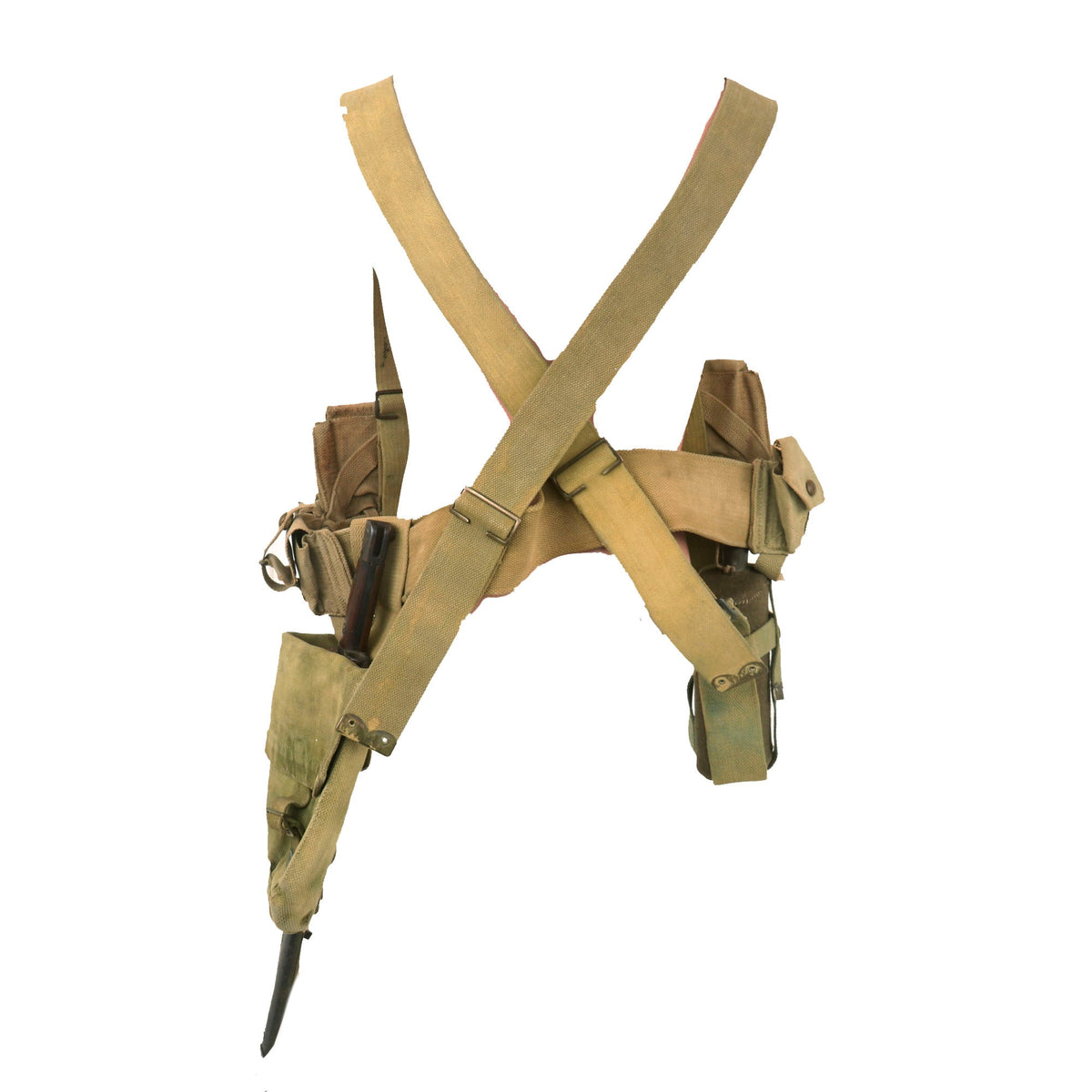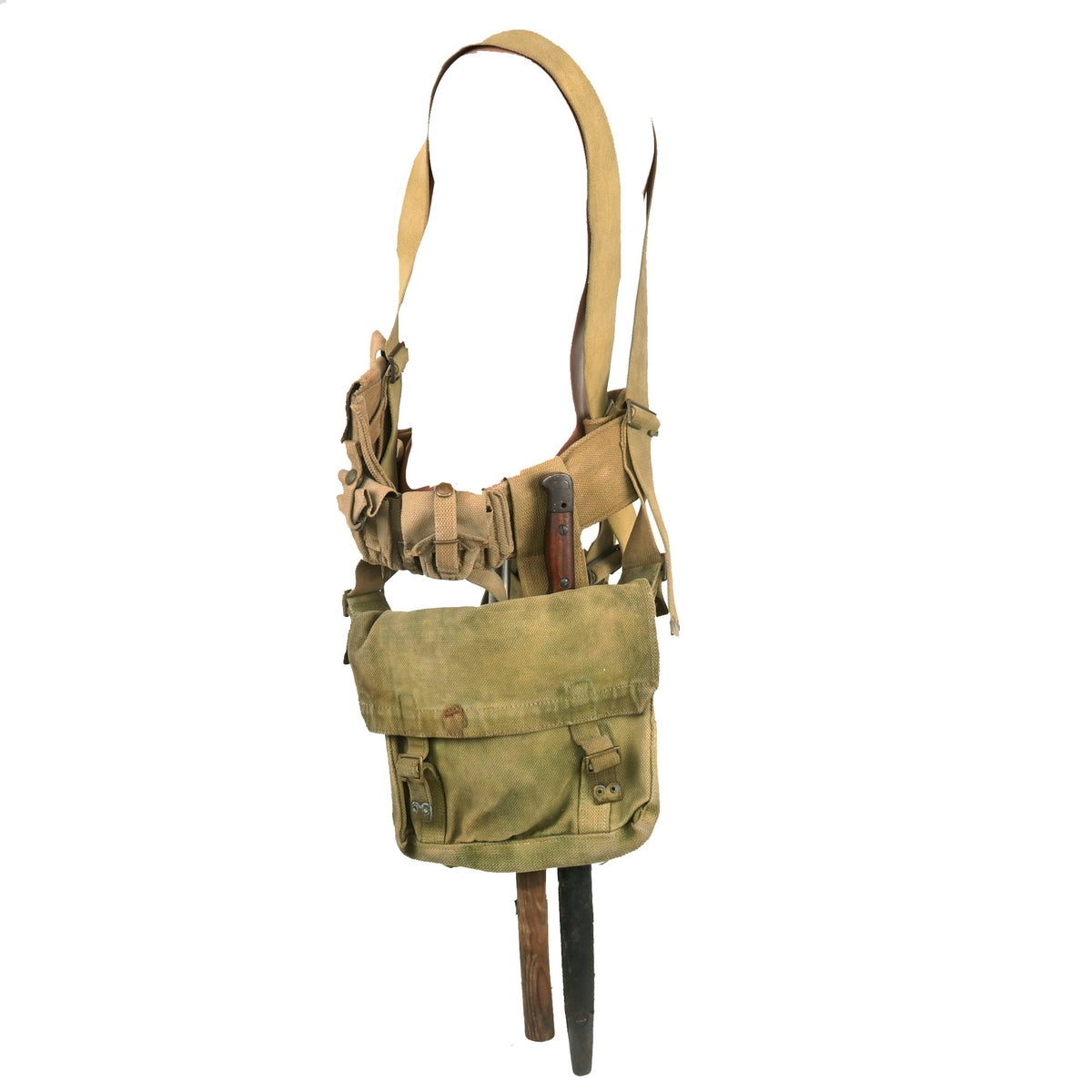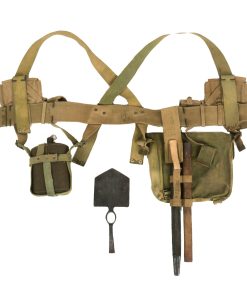Original British WWI Pattern 1908 Webbing Gear Set WIth Rare Helve Carrier New Made Items
$ 1.595,00 $ 398,75
Original Items: Only One Set Available. This is a wonderful, near complete set of the famed British Pattern 1908 Webbing Set. The best feature of the lot is the extremely rare Helve Carrier, one of the hardest to find items to complete a Pattern 1908 gear set, making this an excellent offering.
The 1908 equipment, when fully assembled, formed a single piece, and could be put on or taken off like a jacket. Ammunition was stored in two sets of pouches attached to the belt at the front, and the straps from these passed over the shoulders, crossing diagonally at the back. The large pack, or “valise”, or the haversack could be attached to these diagonal straps, thus spreading their weight. The “D” shaped buckles and the strap ends were made of brass. The Haversack would have carried: rations, a mess tin, a white towel, wool shirt, wool socks, a holdall, and a rifle cleaning kit. The holdall would have carried a spoon, knife, fork, button stick, shaving brush, hair comb, toothbrush, razor, a bar of soap, and spare boot laces. The whole set consisted of:
– One belt, three inches (76 mm) wide: Has faint markings but appears to be dated 1916.
– Two braces, two inches (51 mm) wide: Has no markings that we can find.
– Two cartridge pouch sets, each set consisting of five pouches and each pouch holding three five-round stripper clips; 150 rounds of rifle ammunition in total: We could not find any markings.
– One bayonet frog (a tubular carrier which connected the bayonet scabbard to the belt): Bayonet is by WILKINSON and appears to be dated 1916 or 1918 but the markings are very faint.
– One water bottle and carrier
– One haversack: MISSING
– One valise
– Two valise straps
– One entrenching tool with separate carriers for the head and helve
The whole set is offered without any extensive damage but does show signs of faithful field and service wear. Markings very and are mostly faint with some legible. There is some fraying present around the edges and sides of the equipment.
The equipment could be configured in two different ways; for “Full Marching Order” the valise was worn on the back and the haversack was worn hanging at the left hip. In “Battle Order” which was intended to be worn in combat, the valise was detached and the haversack was attached to the back in its place, connected to the ammunition pouches by separate straps. In 1917, an additional haversack in khaki webbing was introduced to hold the Small Box Respirator; it was worn high-up on the chest.
In theory, an infantryman’s Full Marching Order weighed 57 pounds 2+1⁄2 ounces (25.93 kilograms), and the Battle Order weighed 49 pounds 2 ounces (22.3 kilograms), both including the bayonet and 150 rounds of ammunition but excluding the Lee-Enfield rifle. However, in wartime conditions, the addition of new equipment such as the gas mask, steel helmet and hand grenades, together with the need to carry extra ammunition, rations and defence stores, meant that infantrymen could sometimes go into battle carrying loads estimated at up to 114 pounds (52 kilograms).
A wonderful and rare webbing set that comes more than ready for further research and display.
Fast Shipping with Professional Packaging
Thanks to our longstanding association with UPS FedEx DHL, and other major international carriers, we are able to provide a range of shipping options. Our warehouse staff is expertly trained and will wrap your products according to our exact and precise specifications. Prior to shipping, your goods will be thoroughly examined and securely secured. We ship to thousands clients each day across multiple countries. This shows how we're dedicated to be the largest retailer on the internet. Warehouses and distribution centres can be located throughout Europe as well as the USA.
Note: Orders with more than one item will be assigned a processing date depending on the item.
Before shipping before shipping, we'll conduct a thorough inspection of the items you have ordered. Today, the majority of orders will be delivered within 48 hours. The delivery time will be between 3-7 days.
Returns
The stock is dynamic and we cannot completely manage it because multiple stakeholders are involved, including our factory and warehouse. So the actual stock may alter at any time. It's possible that you may not receive your order once the order has been made.
Our policy is valid for a period of 30 days. If you don't receive the product within 30 days, we are not able to issue a refund or an exchange.
You can only return an item if it is unused and in the same state as the day you received it. You must have the item in its original packaging.
Related products
Uncategorized
Uncategorized
Uncategorized
Uncategorized
Uncategorized
Uncategorized
Uncategorized
Uncategorized
Angolan Rebel 1970s era 60mm Inert Display Mortar from Angolan Civil War Original Items
Uncategorized
Uncategorized
Armored Burgonet Helmet & Polearm from Scottish Castle Leith Hall Circa 1700 Original Items
Uncategorized
Band of Brothers ORIGINAL GERMAN WWII Le. F.H. 18 10.5cm ARTILLERY PIECE Original Items
Uncategorized
Uncategorized
Uncategorized
Uncategorized
Australian WWII Owen MK1 Machine Carbine SMG Custom Fabricated Replica with Sling Original Items
Uncategorized
Uncategorized
Uncategorized
Uncategorized
Uncategorized
Armoured Fighting Vehicles of the World: AFVs of World War One (Hardcover Book) New Made Items
Uncategorized
